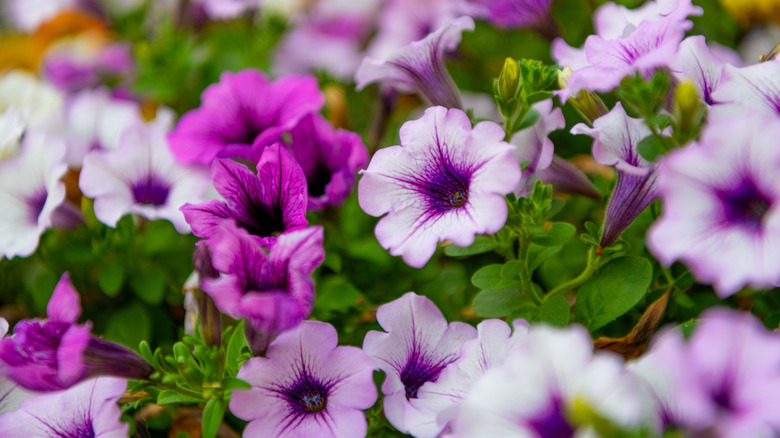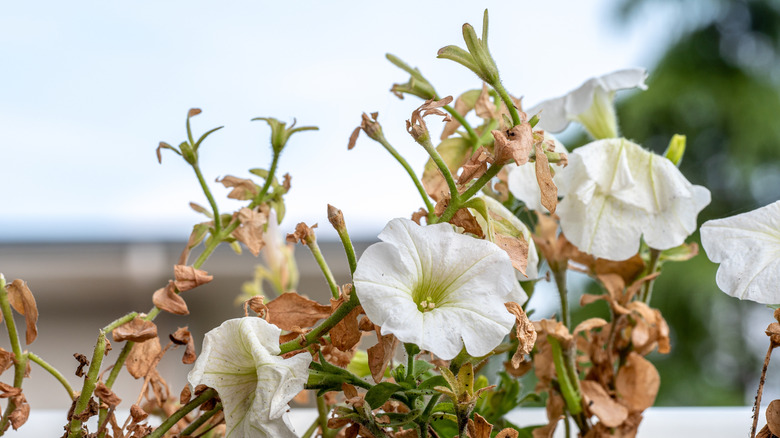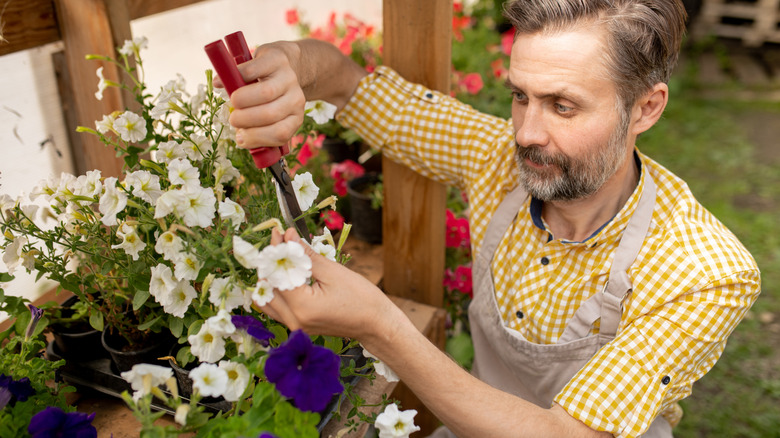Why The Leaves On Your Petunias Are Yellow, Not Green (& If You Should Pluck Them)
Petunias are those charming, low-maintenance flowers that instantly brighten up any garden or porch with lush, colorful flowers. By mid-summer, your petunias are thriving and blooming beautifully. But then, you notice something unexpected, some leaves are starting to turn yellow. Don't panic if you see this happening. This is a common issue among petunias, but it is definitely worth figuring out what's behind the change.
There are a few usual suspects behind the fading foliage. Overwatering is a frequent problem because petunias don't do well in overly wet soil. Too much moisture can suffocate the roots, too little can stress the plant, and both of these situations can result in telltale yellow leaves. The best option is to water thoroughly when the top inch of the soil feels dry when you touch it.
Then, there's the nutrition angle. Lack of essential minerals like nitrogen, potassium, or iron can cause the leaves to yellow in specific patterns (different patterns depending on which nutrient is missing). Regular feeding with a balanced fertilizer and even a quick soil test can help you zero in on what your petunias need. Oh, and don't forget the sun! Petunias love light and need a good 6 hours or more of sun basking each day to stay green and glorious. These basics — sunlight, soil, and correct nutrients — are everything you need to know before planting petunias to give them the best start.
What that yellow color is really telling you
Not all yellowing is the same. In fact, there are specific patterns and locations of the discoloration on your petunia leaves that can offer clues about the underlying problems. For example, if you notice a mosaic-like mottling in yellow across the leaves, it could be the tobacco mosaic virus. If that is the case, then it means bad news for the plant because this is incurable and spreads easily through aphids or even the touch of a tobacco user. In such cases, the best thing to do is to remove and discard the plant immediately (preferably not in your compost bin).
If the yellowing appears between the veins of young leaves, it could point to an iron or magnesium deficiency. For older leaves turning uniformly yellow, the problem may be low nitrogen. Are you seeing brown, necrotic spots following the yellow ones? It might be because of potassium. Understanding the "language" of your plant and its leaves can save you time, effort, and future heartbreak. Petunias benefit when you start seeds indoors for sweet spring blooms, giving them a stronger beginning.
Environmental stress also plays a key role. Petunias are sun lovers and don't handle shade well. If your once-sunny flower bed is now in partial shade due to seasonal changes or growing foliage, your petunias might suffer. So, keep an eye out on how much light they are actually getting as the season progresses, and move containers if needed.
Should you pluck off those yellow leaves?
When you see the yellow leaves, the temptation to pluck them is hard, but is that the right move? Well, it depends. If the yellow leaves are clearly dead, damaged, or diseased, removing them helps prevent any potential spread and encourages the plant to focus its energy on healthy growth. Just be gentle and use clean scissors or garden shears to avoid putting strain on the plant.
However, if the leaves are just slightly yellow and the plant is otherwise healthy, consider addressing the root cause first. Sometimes, petunias will bounce back quickly once their water, light, or nutrient issues are resolved, and the yellowing may reverse or stop progressing. In this case, patience may actually serve you better than pruning. It may not be too late to turn things around and bring your dying petunias back to life.
Also, keep in mind that over-pruning can cause additional stress, especially if the plant is already struggling. As a rule, limit pruning to maintain a balance and support the plant while it recovers. However, make sure not to overwhelm it with too many changes at once. To keep your petunias thriving, it's helpful to avoid some of the more common pitfalls that can sabotage their health early on.


